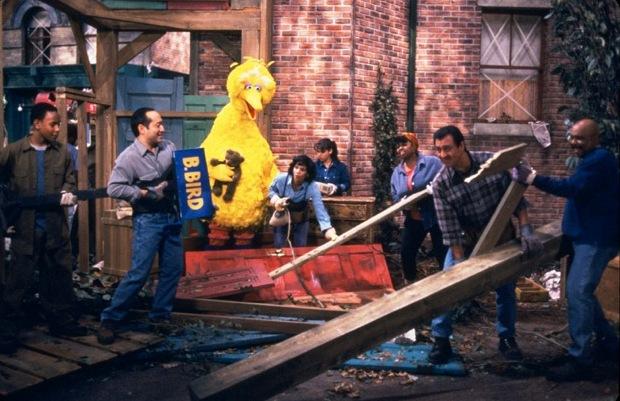Because of Superstorm Sandy — and despite the destructive hurricane that hit the eastern coast last week — Sesame Street's Friday, Nov. 9 episode has been designed to ease the fears and bad memories that may have been left with the series' many young fans.
Shortly after the storm hit last week, those involved in producing the long-running children's series knew they would take existing resources and quickly turn them into a show designed to comfort children affected by the storm, said Nadine Zylstra, the show's supervising producer, in a Tuesday phone interview. Even though they couldn't get into their New York production facilities until late last week, the decision was made before that to quickly adapt a five-episode story that was made in 2001 to help children understand and prepare for hurricanes into a program that would assist children in dealing with what the hurricane did to them.
"We totally changed the focus," she said, from one of preparing to one of rebuilding.
In the just-completed, newly edited episode, Big Bird's nest is destroyed after a hurricane hits Sesame Street. Here's part of the story summary: "Big Bird’s friends and neighbors gather to show their support and let him know they can fix his home, but it will take time. While everyone on Sesame Street spends the next few days cleaning up and making repairs, Big Bird still has moments where he is sad, angry and confused. His friends help him cope with his emotions by talking about what happened, drawing pictures together and giving him lots of hugs. They also comfort Big Bird by offering him temporary places he can eat, sleep and play. Big Bird remembers all the good times he had at his nest and realizes that once it is rebuilt, there are more good times and memories to come."

For many decades, Sesame Street has communicated effectively with young children in a way few other media sources ever have. No doubt, boys and girls who have never dealt with destruction and uncertainty like this before will benefit from that way the program's characters connect with their fans.
The show's website is supplementing the program's content with additional hurricane-themed information.
Getting to this point so quickly was no easy job. The 2001 tape footage that would have to be quickly edited was in a Queens storage facility. But there was no gasoline to drive it to Manhattan. Supervising Producer Benjamin Lehmann, fortunately, lives in Queens, he said, and was able to bring it with him on a subway trip.
The series' editor lives in New Jersey but, because of carpooling restrictions, couldn't get across the bridge — by Monday he was able to get to Manhattan on an early morning ferry. His assistant, while trying to commute on a bicycle, was involved in a Manhattan auto accident.
Once the tape reached the building, there was the problem that it was shot on a format no longer used by the show. Lehmann said there was a sole remaining tape deck in the building that handled the old format, and it became a very valuable lifeline as the show's producers edited five hours down to one.
"At one point we said we should have been shooting behind the scenes," Zylstra said, so all of the obstacles and their solutions could have been recorded.
The two producers said the many hours of work, in and around a hurricane that touched their personal as well as their professional lives, was worth it.
"Everybody who has been involved in the special has been so energized," Zylstra said. "We consider it a moving thing to be involved in."
Check local listings for broadcast times in your area.